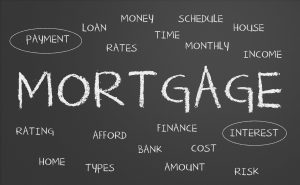When you shop for a home, you might hear a bit of industry lingo you’re not familiar with. We’ve created an easy-to-understand directory of the most common mortgage terms.
Amortization
Part of each monthly mortgage payment will go toward paying interest to your lender, while another part goes toward paying down your loan balance (also known as your loan’s principal). Amortization refers to how those payments are broken up over the life of the loan. During the earlier years, a higher portion of your payment goes toward interest. As time goes on, more of your payment goes toward paying down the balance of your loan.
Down Payment
The down payment is the money you pay upfront to purchase a home. In most cases, you have to put money down to get a mortgage.
The size of the down payment you’ll need will vary based on the type of loan you’re getting, but a larger down payment generally means better loan terms and a cheaper monthly payment. For example, conventional loans require as little as 3% down, but you’ll have to pay a monthly fee (known as private mortgage insurance) to compensate for the small down payment. On the other hand, if you put 20% down, you’d likely get a better interest rate, and you wouldn’t have to pay for private mortgage insurance.
A mortgage calculator can help you see how your down payment amount affects your monthly payments.
Escrow
Part of owning a home is paying for property taxes and homeowners insurance. To make it easy for you, lenders set up an escrow account to pay these expenses. Your escrow account is managed by your lender and functions kind of like a checking account. No one earns interest on the funds held there, but the account is used to collect money so your lender can send payments for your taxes and insurance on your behalf. To fund your account, escrow payments are added to your monthly mortgage payment.
Not all mortgages come with an escrow account. If your loan doesn’t have one, you have to pay your property taxes and homeowners insurance bills yourself. However, most lenders offer this option because it allows them to make sure the property tax and insurance bills get paid. If your down payment is less than 20%, an escrow account is required. If you make a down payment of 20% or more, you may opt to pay these expenses on your own or pay them as part of your monthly mortgage payment.
Keep in mind that the amount of money you need in your escrow account is dependent on how much your insurance and property taxes are each year. And since these expenses may change year to year, your escrow payment will change, too. That means your monthly mortgage payment may increase or decrease.
Interest Rate
An interest rate is a percentage that shows how much you’ll pay your lender each month as a fee for borrowing money.
There are two types of mortgage interest rates: fixed rates and adjustable rates.
Fixed Rates
Fixed interest rates stay the same for the entire length of your mortgage. If you have a 30-year fixed-rate loan with a 4% interest rate, you’ll pay 4% interest until you pay off or refinance your loan. Fixed-rate loans offer a predictable payment each month, which makes budgeting easier.
Adjustable Rates
Adjustable rates are interest rates that change based on the market. Most adjustable rate mortgages begin with a fixed interest rate period, which usually lasts 5, 7 or 10 years. During this time, your interest rate remains the same. After your fixed interest rate period ends, your interest rate adjusts up or down every 6 months to a year. This means your monthly payment can change based on your interest payment.
ARMs are right for some borrowers. If you plan to move or refinance before the end of your fixed-rate period, an adjustable rate mortgage can give you access to lower interest rates than you’d typically find with a fixed-rate loan.
Loan Servicer
The loan servicer is the company that’s in charge of providing monthly mortgage statements, processing payments, managing your escrow account and responding to your inquiries.
Your servicer is sometimes the same company that you got the mortgage from, but not always. Lenders may sell the servicing rights of your loan and you may not get to choose who services your loan.
Loan Types
There are many types of mortgage loans. Each comes with different requirements, interest rates and benefits. Here are some of the most common types you might hear about when you’re applying for a mortgage.
FHA Loans
FHA loans are a popular choice because they have low down payment and credit score requirements. You can get an FHA loan with a down payment as low as 3.5% and a credit score of just 580.
These loans are backed by the Federal Housing Administration; this means the FHA will reimburse lenders if you default on your loan. This reduces the risk lenders are taking on by lending you the money; this means lenders can offer these loans to borrowers with lower credit scores and smaller down payments.
Conventional Loans
The phrase “conventional loan” refers to any loan that’s not backed or guaranteed by the federal government. Conventional loans are often also “conforming loans,” which means they meet a set of requirements defined by Fannie Mae and Freddie Mac – two government-sponsored enterprises that buy loans from lenders so they can give mortgages to more people.
Conventional loans are a popular choice for buyers. You can get a conventional loan with as little as 3% down. If you put down less than 20% for a conventional loan, you’ll usually be required to pay a monthly fee called private mortgage insurance, which protects your lender in case you default on your loan. This adds to your monthly costs but allows you to get into a new home sooner.
USDA Loans
USDA loans are only for homes in eligible rural areas (although many homes in the suburbs qualify as “rural” according to the USDA’s definition.). To get a USDA loan, your household income can’t exceed 115% of the area median income.
USDA loans are a good option for qualified borrowers because they allow you to buy a home with 0% down. For some, the guarantee fees required by the USDA program cost less than the FHA mortgage insurance premium.
VA Loans
VA loans are for active-duty military members and veterans. Backed by the Department of Veterans Affairs, VA loans are a benefit of service for those who’ve served our country. VA loans are a great option because they let you buy a home with 0% down and no private mortgage insurance.
Mortgage Payment
Your mortgage payment is the amount you pay every month toward your mortgage. Each monthly payment has four major parts: principal, interest, taxes and insurance.
Principal
Your loan principal is the amount of money you have left to pay on the loan. For example, if you borrow $200,000 to buy a home and you pay off $10,000, your principal is $190,000.
Part of your monthly mortgage payment will automatically go toward paying down your principal. You may also have the option to put extra money toward your loan’s principal by making extra payments; this is a great way to reduce the amount you owe and pay less interest on your loan overall.
Interest
The interest you pay each month is based on your interest rate and loan principal. The money you pay for interest goes directly to your mortgage provider. As your loan matures, you pay less in interest as your principal decreases.
Taxes And Insurance
If your loan has an escrow account, your monthly mortgage payment may also include payments for property taxes and homeowners insurance. Your lender will keep the money for those bills in your escrow account. Then, when your taxes or insurance premiums are due, your lender will pay those bills for you.
Mortgage Term
Your mortgage term refers to how long you’ll make payments on your mortgage. The two most common terms are 30 years and 15 years. A longer term typically means lower monthly payments. A shorter term usually means larger monthly payments but huge interest savings.
Private Mortgage Insurance
Private mortgage insurance is a fee you pay to protect your lender in case you default on your conventional loan. In most cases, you’ll need to pay PMI if your down payment is less than 20%. The cost of PMI can be added to your monthly mortgage payment, covered via a one-time upfront payment at closing or a combination of both. There’s also a lender-paid PMI, in which you pay a slightly higher interest rate on the mortgage instead of paying the monthly fee.
Promissory Note
A promissory note (or mortgage note) is like an IOU that includes all of the guidelines for repayment. It is the written promise or agreement to pay back the loan using the agreed-upon terms. These terms include:
- Interest rate type (adjustable or fixed)
- Interest rate percentage
- Amount of time to pay back the loan (loan term)
- Amount borrowed to be paid back in full
Once the loan is paid in full, the promissory note is given back to the borrower. If you fail to uphold the responsibilities outlined in the promissory note (i.e. pay back the money you borrowed), the lender can take ownership of the property.





This Post Has One Comment
Comments are closed.